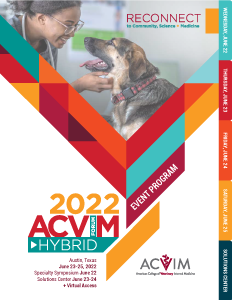To Earn CE for this Session: Watch the on-demand recording in its entirety to unlock the CE quiz. Then click here to complete the CE quiz for this session.
Research Abstract - Oral
Neurology
N11 - Prevalence and Clinical Features of Thoracolumbar Intervertebral Disc-associated Epidural Hemorrhage in Dogs

Jenni Bridges, DVM
Neurology Specialty Intern
Wheat Ridge Animal Hospital
Denver, Colorado, United States
Research Abstract - Oral Presenter(s)
Background: Intervertebral disc-associated epidural hemorrhage (EH) in dogs is a poorly understood neurological condition.
Objective: To compare the signalment, clinical presentation, MRI changes, and clinical outcome of dogs with acute thoracolumbar intervertebral disc herniation (TL-IVDH) with and without EH.
Animals: 160 client-owned dogs that underwent MRI and hemilaminectomy for acute TL-IVDH at a private practice in Colorado, including 63 dogs with EH and 97 dogs without EH.
Methods: Retrospective review of medical record data from 160 dogs presenting sequentially to a single practice with acute TL-IVDH that underwent MRI and hemilaminectomy surgery.
Results: 63 of 160 (39%) dogs had confirmed EH. French Bulldogs were significantly over-represented (23/63; OR 4.1; 95% CI: 1.8 – 9.0; p<0.001) of the EH cases. Dogs with EH were more likely to present with clinical signs under 48 hours than dogs without EH (24-48 hours vs 48-72 hours; OR 2.4; 95% CI: 1.2 – 4.6; p=0.023) and were more likely to be non-ambulatory on presentation (OR 2.1; 95% CI: 1.0 – 4.1; p=0.044). MRI showed that dogs with EH were more likely to have <50% cross-sectional spinal cord compression than dogs without EH (OR 2.3 vs. 0.4; 95% CI 1.2 – 4.4 and 0.2 – 0.9, respectively), longer longitudinal spinal cord compression (3 spaces vs 1 space, p<0.001), and greater intrinsic spinal cord change (grade 3/severe vs grade 1/mild; p<0.001). The location of the intervertebral disc herniation in French Bulldogs with EH was more likely to be thoracolumbar (OR 10.8; 95% CI: 2.1 – 55.7; p=0.033).
Conclusions and clinical importance: French Bulldogs have a high prevalence of intervertebral disc-associated EH. Dogs with EH have a shorter clinical course, are more likely to present non-ambulatory, and have milder compression with more severe intrinsic spinal cord changes on MRI.

